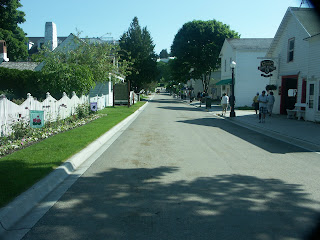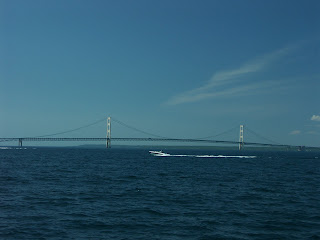Shortly after we arrived on Mackinac Island and unloaded our luggage at Metivier Inn, Alyssa took me on my walking tour of the island. Many of you may know that Mackinac Island is Michigan's first State Park, but did you know that in 1875 the federal government established the second national park (the first was Yellowstone), the Mackinac Island National Park? With the closure of Fort Mackinac in 1895, the federal government gifted this national park to the state of Michigan.
About 2 pm my "tour" began, We headed east on Market Street until we came to the base of Fort Mackinac. We turned left and ascended Fort Street, a.k.a. "Killer Hill". I had heard them refer to Killer Hill several times in the past, I was about to experience it firsthand. Whew, it was a mighty sleep climb!
Here's the view of Trinity Episcopal Church with downtown in the background from about half-way up Killer Hill.
On flat ground, and above the city, we had a great view of a freighter passing in the shipping channel with seemingly tiny Round Island Lighthouse to the far right!
The Governor's Summer Residence...Gov. Snyder was not present while we were there. Perhaps the state could pick up a few extra dollars by renting some of the rooms out during the tourist season! "Rick's B&B"!
In regards to transportation, there are no motorized vehicles allowed on the island (except for ambulance, police and fire vehicles). So, 500 or so year-round residents primarily get from place to place by walking, biking or horseback. The option for horse-drawn carriage is used primarily by visitors on tours or as a taxi service.
By the time we had reached the Scout Barracks,
the Boy Scouts were in formation outside
presumably receiving instructions for the week.

The hike continued down, I believe, Rock Trail. We prefered the dirt nature trails over the
pavement any day! And we were rewarded
by a somewhat large "garden" of
Yellow Large Ladies' Slippers!
The trail continued until we arrived at one of the
more visited locations on the island, Arch Rock.
Once upon a time, this was a complete wall of
limestone. However thousands of years of

wave action from the ancient Lake Algonquin, whose level was much higher than present day, eroded the soft limestone.
However, Indian folklore tells the tale of a
Chippewa Chief's daughter who falls madly in
love with an immortal. So, her father took her to
the Island of The Great Turtle (Mackinac Island)
and placed her atop a cliff and refused to bring
her home until she agreed to marry a mortal.
She refused to comply with her father's orders and
wept continuously, eventually washing away
the ground beneath her forming Arch Rock.
A view of Lake Shore Road and Lake Huron
from Arch Rock.

I'm not quite sure what this unusual bloom was
but found its color and structure rather interesting.
We headed back down one of the trails and would up at another geologic locale, Skull Cave. Like Arch Rock, the soft limestone center gradually eroded from wave action from the elevated waters about 11,000 years ago. It was given the name Skull Cave in 1763, when British fur trader Alexander Henry took refuge in the cave during an Indian uprising and noticed that the floor of the cave was littered with human bones!

One of the three cemeteries on Mackinac Island,
St.Anne's. To secure burial in this location, you
must either have been born on the Island, or
resided here for 15 years.
Across from St. Anne's Cemetery is Post
Cemetery. The oldest on the Island, it contains 108 graves,mainly those of soldiers that were stationed at Fort Mackinac, family members of those buried here and a hand full of civilians who lived on the Island.
Burials began at this location in 1796 and ceased in 1892. It is now closed to burial and considered a National Cemetery.
One of the many burial sites of an unknown soldier most likely from the early to mid 1800's.

We continued on a trail near the cemetery to an overlook at Point Lookout where we could see Sugar Loaf Rock below! It is another ancient limestone formation that towers 79 feet tall and the home of Gitchee Manitou, the Great Spirit, according to Ojibwa tradition.
Next up was Fort Holmes. After the Brits seized Fort Mackinac in the first battle of the War of 1812, they built Fort George high atop a bluff to provide another fortified location to the east of the fort to assist in the defense of Fort Mackinac. In 1815, The Treaty of Ghent gave Mackinac Island back to the U.S.A., when it was promptly renamed Fort Holmes, after Major Andrew Holmes who died on the Island in 1814 during a battle to attempt to re-take Fort Mackinac. Soon after U.S. troops resumed post on the island, Fort Holmes was abandoned and this is all that remains.
More flora.....Lyre-Leaved Rock Cress.
And the tour ended where else, but Killer Hill!
 Unfortunately, when we arrived 10 minutes later, he had just left with the other scouts in his patrol for their afternoon duties in town!
Unfortunately, when we arrived 10 minutes later, he had just left with the other scouts in his patrol for their afternoon duties in town!  After returning our bikes and a great burger and shake lunch at Fred's, we headed back to Metivier Inn to collect our luggage. And that's when I spotted one of the few vehicles allowed on the Island! Ambulance, police and a firetruck are the only motorized vehicles allowed here!
After returning our bikes and a great burger and shake lunch at Fred's, we headed back to Metivier Inn to collect our luggage. And that's when I spotted one of the few vehicles allowed on the Island! Ambulance, police and a firetruck are the only motorized vehicles allowed here!





















































